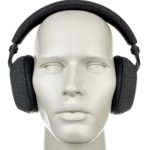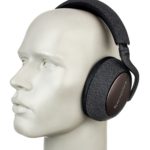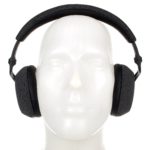As with its on-ear counterpart, I would give a clear letter of recommendation to the PX7. Where the PX7 loses out for me is the price, since it does not justify the extra 100 EUR on top of the cost of the on-ear model. The competition for the PX5 comes from in-house. But if you want an ear–enclosing version of the current Bowers & Wilkins headphones, you can’t go wrong with the PX7.
As the PX5 on-ear version quite impressed us (see the test here), Bowers & Wilkins also sent their top model from the 2019 line-up to the editors. The essential difference is the design: Enclosing the ear instead of lying on the ear, so the only question that should concern us is whether or not the 100 euro surcharge means that the PX5 can be topped.

External values
The slipcase includes a zippered hard case, two 1-meter USB cables and mini-jacks on both sides. Like the PX5, the PX7 can also be operated in classic analog mode.
The headphones themselves have a composite fibreglass headband that is very robust and forces me to make the statement that this component cannot actually break. The headband, which is virtually identical in construction to the PX5, is covered with fabric, just like its on-ear counterpart. On the underside, we find soft, fine leather. The same materials cover the two ear cups on the inside, the operating buttons of which are identical to those on its sister model.
You won’t find any gesture controls or touch-sensitive outer sides, but the buttons that are easy to locate, which I find very convenient. Even more convenient for me on the PX7, is the clever sensor technology, which virtually takes care of the operation, but more on that later.
Best connections
The two 2019 series PX headphones offer the best in Bluetooth codec and profile technology. On the audio side, for example, the Qualcomm aptX HD codec is supported, which, with the appropriate player, reproduces HighRes audio files in the highest quality. Just like the PX5; the PX7 is virtually identical. For the first time the aptX Adaptive Codec is used. However, we couldn’t test it in terms of audio quality, as we didn’t have any compatible players available. Pairing with a maximum of two devices, which can be operated simultaneously, was no problem. This ability to memorize connections and quickly re-establish them is a great blessing in our line of work.
Noise Cancelling
The very effective adaptive noise cancelling offers three different operating states, which can be toggled via the button on the bottom left. “Low” barely lets ambient noise pass through; you still get a little bit of the outside world; conversations, keyboard rattles, doorbells are perceptible. “High” is a strong shield, but even here the noise of another person talking loudly or the keyboard rattles of your office neighbour have not completely disappeared. But this is only disturbing when power napping without music.
Interesting is the ANC mode “Auto”. Here external tests showed that all sounds arriving from the front are damped as much as possible. However, sounds arriving from the side are let through. This can, of course, be practical in the city if you can detect an approaching tram earlier in order to avoid danger. When walking through the woods, an approaching herd of wild boar would be recognised much earlier!
For those who are like me, and cannot climb a tree very fast, I recommend the function called “communication mode” or “environment switching”. A longer press on the button reduces the music extremely and lets ambient noises captured via the microphone through. What is remarkable here is the quality of the “live transmission”. The sound corresponds as far as possible to natural hearing.
The passive noise cancelling, i.e. the shielding by the ear cushions alone, is sufficient for everyday situations.
Overall the ANC of the PX7 gets full marks from me, especially since the sound hardly changes at all during analog transmission. Noise is also in the barely perceptible range – here the engineers have done a great job.
Handling
The features I really liked about the PX5 are also offered by the technology of the PX7. Sensors register the position of the headphones; even the brief release of an earpiece from the ear generates a pause command to the player. Thus, you are largely freed from operating steps. With the PX7, the fine-tuning of the user controls didn’t seem to be finished yet. I had to increase the sensitivity of the sensors in the app in order to achieve a similar result as I did with the PX5.
The usual tests in everyday office life came out positive, similar to the PX5. Skype calls and video conferencing via Slack worked well. Also, speech intelligibility during telephone calls was basically good. Working on the computer via Bluetooth was very easy, incoming telephone calls on the second (Bluetooth) line automatically interrupted media playback on the computer via a pause command. In addition, the PX7 can also be used as an audio device (sound card) via USB, so music could be streamed digitally. Thus, media jobs such as audio and video editing are virtually latency-free.
The battery life was 30 hours with activated Noise Cancelling, and this should not lead to problems if sufficient attention is paid to recharging, especially since USB-C can also be used to recharge the headphones very quickly. The battery of the PX7, like that of the PX5, should be replaceable. I think that this will happen as a service you will be able to buy from specialist dealers.
Sound
The sound texture of the PX7 is very similar to that of the PX5, which is not surprising. The strengths of the current Bowers & Wilkins headphones are obviously in evidence in their top model: The PX7 reproduces all styles to the highest satisfaction across all genres without interference and in a detailed manner. This means the possibility of streaming high-resolution audio via Bluetooth that should convince even audio purists. I refer to our results when we tested the PX5.
Although I tested both B&W headphones at different times, I dare say that both sound very similar and that the PX7 gets the highest score from me.
With the PX7, the larger diaphragm and the greater sound space provided by the design allow for greater agility. The acoustic bass on “The Energy Of A Small Woman” from our Spotify Playlist moves the air under this headphone in a very elegant way, and “Mr Chicken” is also performed brilliantly on the bass side. And a PX7 with activated noise cancelling can make Maurice Ravel’s “Bolero” even in a slightly noisy environment an absolute pleasure. Beginning with the pianissimo at the beginning, the congenial piece builds up from the depth of the room to a tossing orchestral masterpiece within 15 minutes. The PX7 masters this with brilliance. Dynamics, depth and well-balanced acoustic images across all areas with a slight tendency to gloss over, on the one hand pleasingly satisfy the taste of discerning users, but on the other hand can also satisfy the highest hi-fi demands, at the latest via cable or by using the aptX codecs provided.
The listening test of the PX7 reinforces the impression that Bowers & Wilkins is currently setting a standard in its class in terms of sound quality that the competitors in this price range can hardly beat.
Technical specifications
- Ear couplingOver-ear
- Typeclosed
- Transducer principledynamic
- Frequency response (headphones)10 - 30.000 Hz
- Weight without cable310 g
What's in the box
- Mini jack cable
- USB-A to USB-C cable
- Carrying case
Special features
- Available in grey and silver
- BT codecs: aptX Adaptive, aptX HD, aptX Classic, AAC, SBC
- BT version: 5.0
- BT profiles: A2DP v1.3.1, AVRCP v1.6.1, HFP v1.7.1, HSP v1.2, BLE GATT (Generic Attribute Profiles)























































I had the px7s for 18 months, my 3rd set of bower and wilkins! I’ve always loved the Aesthetics and designs but I was never entirely convinced with there sound signature on the px7s , too warm and dark sounding with vocals lost in the background somehow, strangely some music suited them ( R n B) heavy bass tracks ect, but with long anticipation I’ve now replaced them with Dali’s io-6 which is what I’ve been looking for, clean without being too bright, fantastic dynamic mid range with enough weight and punch at the low end, vocals are more present and forward, I just wish they didn’t look too bulky and more discreet like the bowers do, on a score I’d give the px7s a 7 on sound where it’s a definite 9 with the io-6 s, the rest of the design and features score back slightly higher to the px7s but if sound is your preference, a subjective listing is needed!